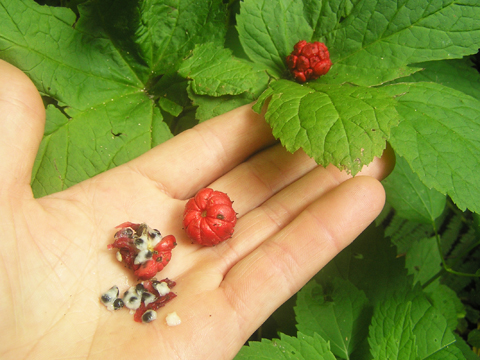 |
| Home | Ordering By Mail | Purchase Manual: Using Native Plants in Urban Landscapes |
|
|||||
Species Name: Hydrastis canadensis
Common Name: Goldenseal
Zone: 4 to 8
Distribution: Vermont to Michigan in the north, south to North Carolina and Arkansas .
Seed collection: Collect fruits when they change color from green to pink. Color change indicates seed maturity. The fruits may remain on the plant for several weeks before they begin to decompose on the plant and disperse their seeds. Each fruit contains a couple dozen small black seeds.
Seed handling: Remove the seeds from the pulp by crushing and floating off the pulp in water. The seed sinks and is left behind. Immediately place seed in moist potting mix for storage, sow seed immediately in flats or sow seed in the ground.
Germination requirements: If seed is collected soon after ripening, cleaned and sown, germination will likely occur the second spring after planting. If harvest is delayed or seed is allowed to dry out, then germination may take an additional year or longer. The simplest method is to sow seed in the ground where it can be left until it germinates and can grow undisturbed for a couple of years. No matter what strategy you use, golden seal requires patience.
Ecology: Golden seal is a long-lived woodland forb that has been nearly extirpated in the wild, from over harvesting for medicinal purposes. It is a valuable addition to the woodland plant community and should be restored to natural woodlands where possible. It also has nearly 100% resistance to deer browsing, so it should be planted and established where deer populations are high.
Golden seal spreads slowly by rhizomes as well as reproducing from seed. It grows in moist, fertile, well-drained woodland soils in half sun to full shade. It grows in slightly acid to neutral soils. It commonly grows in association with other woodland wildflowers such as may apple, trillium, blood root, and black cohosh.
It is relatively easy to collect and plant the seed for reestablishment. Reintroduced golden seal into natural woodlands wherever suitable habitat is found. An easy way to get started is to purchase a few plants and plant them in your yard. Harvest the seed when the plants begin to flower and produce fruits.

Harvest fruits as soon as they change color and remove seeds.
this page updated February 5, 2011